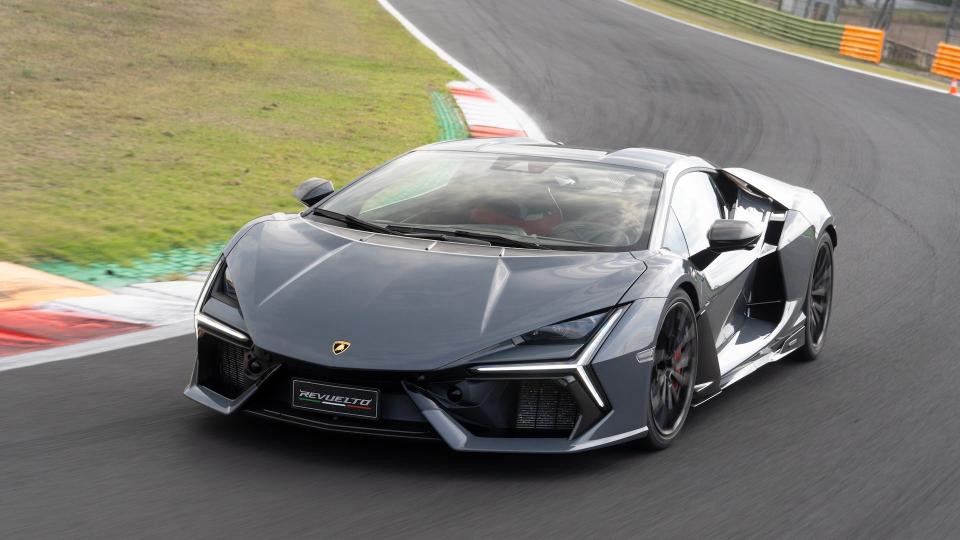2024 Lamborghini Revuelto First Drive Review: A Sharp Step Into the Electrified Era

By the end of my fourth track stint in the new Lamborghini Revuelto, I finally built up enough confidence to sneak a peek at the speedometer just before hitting top speed on Autodromo de Vallelunga’s long front straight. The digital readout spins past 174 mph before wisdom dictates that I glance back up and punch the brakes, setting enough weight on the nose to elicit a hint of understeer before the front tires pull me straight through a wide pair of S turns.
The following lap borders on lunacy, as four massively wide Bridgestone Potenza Sport tires never quite recover from that first hard effort scrubbing speed. By the time I’m rounding back onto the front straight, I figure the time has come to truly test Lambo’s stability and traction control programming, so I let the slip-and-slide transition into a full four-wheel drift around a slow and steady sweeper.

The Revuelto takes such shenanigans in stride, almost casual really, for a $600,000-plus all-wheel-drive hypercar. But therein also lies the Revuelto’s perplexing quandary that I never quite manage to resolve. I’m in a 1,001-horsepower hybrid and just hit the highest speed I’ve ever reached in a motor vehicle, entirely without breaking a sweat, but all the performance comes at the cost of weight hidden so well that only premature tire wear reveals the immense complexity beneath all that angular, carbon-fiber skin.
2024 Lamborghini Revuelto Specs | |
|---|---|
Another Step Toward The Electric Age
Hybridization represents the next logical step in Lamborghini’s overarching procession toward full electrification. As the flagship Aventador’s replacement, the Revuelto ditches the innovative hybrid supercapacitor system of the limited-edition Sián from 2019, which provided a bit of boost to smooth out shifting of a famously horrendous seven-speed automated manual gearbox. Those supercapacitors save weight but can’t hold enough charge to serve as a traditional “plug-in” hybrid power. Instead, Lambo comprehensively upgraded the Aventador’s naturally-aspirated V12 engine with new intakes and a higher compression ratio, saving 37 pounds in the process and upping the redline to a screaming 9,500 rpm. It then bolted on three electric motors (two front, one rear), mounted a 3.8-kWh battery in a longitudinal tunnel, and spent no small amount of time at the computer to make all the components play well together.




Much of the Revuelto’s futuristic engineering harkens back to Lambo’s long history. Six decades ago, the Miura arguably inaugurated the supercar era with a V12 mounted transversely behind the cockpit, with a transaxle packed in tight and routing power to the rear wheels. As the Miura’s successor, the Countach flipped its V12 around 90 degrees to a longitudinal arrangement, with a gearbox ahead of the engine—a layout that would power the Diablo, Murcielago, and Aventador while allowing for an easy transition to all-wheel drive. (The two smaller Audi R8-based siblings built under Volkswagen AG’s umbrella, the Gallardo and Huracán, used a similar layout but a V10 instead.)

The Huracán will get one more year of naturally aspirated internal-combustion V10 engines for 2024, before chasing the Revuelto into hybridization. By 2028, the Lanzador EV concept unveiled at Monterey Car Week this year will enter production. If early indications of the Revuelto’s driving dynamics hint at that future, as lamentable as the loss of screaming V12 engines might be, the future of Lamborghini performance looks very bright indeed.
Clever Programming Makes All The Difference
Perhaps the single most impressive thing about the Revuelto is that I would never have accurately guessed the car’s weight if not reading the spec sheet (and keeping an eye on tire wear after each track session). A far roomier cabin thanks to 3.14 additional inches of wheelbase and another inch of headroom contributes to a feeling of airiness entirely absent from the Avendator. A thinner steering wheel rim with electric assist makes spinning through a tighter ratio rack almost too easy but feels weighty enough at speeds below triple digits to retain an exotic level of engagement.



I know in my mind that it’s all smoke and mirrors to mask a dry weight of 3,906 pounds, but the concerted effort works. I never get tired at nine or even ten-tenths, other than maybe my left leg from bracing against the dead pedal during hard braking—as usual, a real racing harness would make a big difference for any serious track time.
But the feel and modulation of the electrically assisted brakes also emerge as more important than outright stopping power. The two front electric motors allow for regen to blend in up to 0.3 g of deceleration, while also using essentially reverse torque vectoring rather than traction control or ABS to noticeably prevent any sloppiness while trail braking. That means I can brake later, with predictable confidence at apex and not a hint of torque steer once I jump back on the go pedal.


 Yahoo Autos
Yahoo Autos 